
Leopold Mozart
Encyclopedia
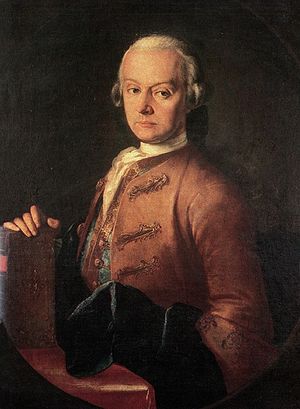
Germans
The Germans are a Germanic ethnic group native to Central Europe. The English term Germans has referred to the German-speaking population of the Holy Roman Empire since the Late Middle Ages....
composer, conductor, teacher, and violinist. Mozart is best known today as the father and teacher of Wolfgang Amadeus Mozart
Wolfgang Amadeus Mozart
Wolfgang Amadeus Mozart , baptismal name Johannes Chrysostomus Wolfgangus Theophilus Mozart , was a prolific and influential composer of the Classical era. He composed over 600 works, many acknowledged as pinnacles of symphonic, concertante, chamber, piano, operatic, and choral music...
, and for his violin
Violin
The violin is a string instrument, usually with four strings tuned in perfect fifths. It is the smallest, highest-pitched member of the violin family of string instruments, which includes the viola and cello....
textbook Versuch einer gründlichen Violinschule
Versuch einer gründlichen Violinschule
Versuch einer gründlichen Violinschule is a textbook for instruction in the violin, published by Leopold Mozart in 1756...
.
Childhood and student years
He was born in AugsburgPrince-Bishopric of Augsburg
The Prince-Bishopric of Augsburg was one of the prince-bishoprics of the Holy Roman Empire, which belonged to the Swabian Circle.-Early period:...
, son of Johann Georg Mozart
Johann Georg Mozart
Johann Georg Mozart was a bookbinder who lived in Augsburg, Germany, in the 17th and 18th centuries. He was the father of Leopold Mozart and the grandfather of Wolfgang Amadeus Mozart....
(1679–1736), a bookbinder
Bookbinding
Bookbinding is the process of physically assembling a book from a number of folded or unfolded sheets of paper or other material. It usually involves attaching covers to the resulting text-block.-Origins of the book:...
, and his second wife Anna Maria Sulzer (1696–1766). From an early age he sang as a choirboy. He attended a local Jesuit
Society of Jesus
The Society of Jesus is a Catholic male religious order that follows the teachings of the Catholic Church. The members are called Jesuits, and are also known colloquially as "God's Army" and as "The Company," these being references to founder Ignatius of Loyola's military background and a...
school, the St. Salvator Gymnasium, where he studied logic, science, theology, graduating magna cum laude in 1735. He then moved on to a more advanced school, the St. Salvator Lyceum.
While a student in Augsburg, he appeared in student theatrical productions as an actor and singer, and became a skilled violinist and organist. He also developed an interest, which he retained, in microscopes and telescopes. Although his parents had planned a career for Leopold as a Catholic priest, this apparently was not Leopold's own wish. An old school friend told Wolfgang Amadeus Mozart in 1777, "Ah he [Leopold] was a great fellow. My father thought the world of him. And how he hoodwinked the clerics about becoming a priest!"
He withdrew from the St. Salvator Lyceum after less than a year. Following a year's delay, he moved to Salzburg to resume his education, enrolling in November 1737 at the Benedictine University
University of Salzburg
The University of Salzburg, or Paris Lodron University after its founder, the Prince Archbishop Paris Lodron, is located in the Austrian city of Salzburg, Salzburgerland, home of Mozart. It is divided into 4 faculties: catholic theology, law, humanities and natural science.Founded in 1622, it...
to study philosophy and jurisprudence. At the time Salzburg was the capital of an independent state within the Holy Roman Empire
Holy Roman Empire
The Holy Roman Empire was a realm that existed from 962 to 1806 in Central Europe.It was ruled by the Holy Roman Emperor. Its character changed during the Middle Ages and the Early Modern period, when the power of the emperor gradually weakened in favour of the princes...
(the Prince-Archbishopric of Salzburg
Archbishopric of Salzburg
The Archbishopric of Salzburg was an ecclesiastical State of the Holy Roman Empire, its territory roughly congruent with the present-day Austrian state of Salzburg....
), now part of Austria
Austria
Austria , officially the Republic of Austria , is a landlocked country of roughly 8.4 million people in Central Europe. It is bordered by the Czech Republic and Germany to the north, Slovakia and Hungary to the east, Slovenia and Italy to the south, and Switzerland and Liechtenstein to the...
. Except for periods of travel, Leopold spent the rest of his life there.
Leopold received the degree of Bachelor of Philosophy in 1738. However, in September 1739 he was expelled from the university for poor attendance, having "hardly attended Natural Science more than once or twice"
Early career as musician
In 1740, he began his career as a professional musician, becoming violinist and valet to one of the university's canons, Johann Baptist, Count of Thurn-Valsassina and TaxisThurn und Taxis
The Princely House of Thurn and Taxis is a German family that was a key player in the postal services in Europe in the 16th century and is well known as owners of breweries and builders of many castles.- History :...
, in 1740. This was also the year of his first musical publication, the six Trio Sonatas, Opus 1. These were entitled Sonate sei da chiesa e da camera; Leopold did the work of copper engraving himself. He continued to compose, producing a series of German Passion cantatas.
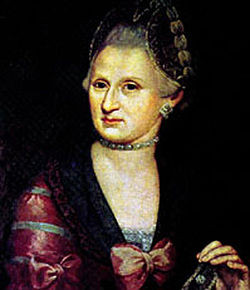
Anna Maria Mozart
Anna Maria Walburga Mozart was the mother of Wolfgang Amadeus Mozart and Maria Anna Mozart.-Biography:...
, who bore him seven children, although only two of them survived past infancy: Maria Anna Wallburga Ignatia
Maria Anna Mozart
Maria Anna Walburga Ignatia Mozart , nicknamed "Nannerl", was a musician, the older sister of Wolfgang Amadeus Mozart and daughter of Leopold and Anna Maria Mozart.-Childhood:...
(called "Nannerl") and Wolfgang Amadeus Mozart
Wolfgang Amadeus Mozart
Wolfgang Amadeus Mozart , baptismal name Johannes Chrysostomus Wolfgangus Theophilus Mozart , was a prolific and influential composer of the Classical era. He composed over 600 works, many acknowledged as pinnacles of symphonic, concertante, chamber, piano, operatic, and choral music...
.
In 1743 Leopold Mozart was appointed to a position (fourth violinist) in the musical establishment of Count Leopold Anton von Firmian, the ruling Prince-Archbishop of Salzburg. His duties included composition and the teaching of violin (later, piano) to the choirboys of the Salzburg cathedral. He was promoted to second violinist in 1758 and in 1763 to deputy Kapellmeister
Kapellmeister
Kapellmeister is a German word designating a person in charge of music-making. The word is a compound, consisting of the roots Kapelle and Meister . The words Kapelle and Meister derive from the Latin: capella and magister...
. He rose no further; others were repeatedly promoted over him to the head position of Kapellmeister.
The question of whether Leopold was successful as a composer (either in terms of artistic success or fame) is debated. The Grove Dictionary says that as of 1756, "Mozart was already well-known. His works circulated widely in German-speaking Europe." However, biographer Maynard Solomon
Maynard Solomon
Maynard Solomon has carried out a multiple career: he was a co-founder of Vanguard Records as well as a music producer, and later became a writer on music.-Career in the recording industry:...
asserts that he "failed to make his mark as a composer,", and Alfred Einstein "judged him to be an undistinguished composer". For discussion of Leopold's musical works, see below.
Scholars agree, however, that Leopold was successful as a pedagogue. In 1755, he wrote his Versuch einer gründlichen Violinschule
Versuch einer gründlichen Violinschule
Versuch einer gründlichen Violinschule is a textbook for instruction in the violin, published by Leopold Mozart in 1756...
, a comprehensive treatise on violin playing
Playing the violin
Playing the violin entails holding the instrument under the chin, supported by the left shoulder . The strings are sounded either by drawing the bow across them , or sometimes by plucking them...
. This work was published in 1756 (the year of Wolfgang's birth), and went through two further German editions (1769, 1787), as well as being translated into Dutch (1766) and French (1770). Today, the work is consulted by musicians interested in 18th century performance practice; see Historically informed performance
Historically informed performance
Historically informed performance is an approach in the performance of music and theater. Within this approach, the performance adheres to state-of-the-art knowledge of the aesthetic criteria of the period in which the music or theatre work was conceived...
. This work made a reputation in Europe for Leopold, and his name begins to appear around this time in music dictionaries and other works of musical pedagogy.
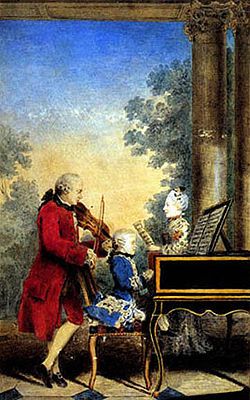
As teacher of Nannerl and Wolfgang
Leopold discovered that his two children were musically gifted in about 1759, when he began with keyboard lessons for the seven-year-old Nannerl. The toddler Wolfgang immediately began imitating his sister, at first picking out thirds on the keyboard and then making rapid progress under Leopold's instruction. By 1762, the children were ready to work as concert performers, and Leopold began taking the family on extensive concert tours, performing for both aristocracy and public, throughout central and western Europe. This tour included Munich, Vienna, Presburg, Paris and the Hague together with a lengthy stay in London; see Mozart family Grand TourMozart family grand tour
The Mozart family grand tour was a journey through western Europe, undertaken by Leopold Mozart, his wife Anna Maria, and their musically gifted children Maria Anna and Wolfgang Amadeus from 1763 to 1766. At the start of the tour the children were aged eleven and seven respectively...
.
The discovery of his children's talent is considered to have been a life-transforming event for Leopold. He once referred to his son as the "miracle which God let be born in Salzburg". Of Leopold's attitude, the Grove Dictionary says:
- "The recognition of this 'miracle' must have struck Leopold with the force of a divine revelation and he felt his responsibility to be not merely a father's and teacher's but a missionary's as well."
By "missionary", the Grove Dictionary refers to the family's concert tours.
Scholars differ on whether the tours made substantial profits. To be sure, often the children performed before large audiences and took in large sums, but the expenses of travel were also very high, and no money at all was made during the various times that Leopold and the children suffered serious illnesses. Mozart biographer Maynard Solomon (1995) takes the view that the tours were lucrative and produced long-term profits for Leopold; Ruth Halliwell (1998) states to the contrary that their income generally only covered their travel and living expenses.
Since the instruction took much of his time, and the touring kept him away from Salzburg for long periods, Leopold cut down his activities in other areas. Nannerl later claimed that he "entirely gave up both violin instruction and composition in order to direct that time not claimed in service to the prince to the education of his two children." After 1762, his compositional efforts seem to have been limited to revising his earlier work; and after 1771 he composed not at all.
The touring continued into the early 1770s. The last three trips were to Italy, with only Leopold accompanying Wolfgang. The failure of Leopold to advance above his Vice-Kapellmeister position at Salzburg is attributed by the Grove Dictionary to the great amount of time that the journeys kept him away from Salzburg (the longest journey was about three and a half years). After the final return from Italy in 1773, Leopold was repeatedly passed over for the Kapellmeister post.
Family life in Salzburg
Although Leopold is portrayed (notably by Halliwell 1998) as generally quite worried about money, the Mozart family by 1773 evidently felt prosperous enough to upgrade their living quarters. They left the home in the Getreidegasse where the children had been born and moved to rooms in the Tanzmeisterhaus ("Dancing-Master's House"), which had been the home of the recently-deceased dancing master Franz Karl Gottlieb Speckner. As tenants of Speckner's cousin and heir Maria Anna Raab, the Mozarts had eight rooms, including the quite large room that Speckner had used for dancing lessons. This the Mozarts used for teaching, for domestic concerts, for storing keyboard instruments sold by Leopold, and for BölzlschiessenBölzlschiessen
Bölzlschiessen was a form of domestic recreation that involved shooting darts at decorated targets with an air gun. It is remembered as an activity of Leopold Mozart, his family, and their friends. The most famous participant was Leopold's son Wolfgang Amadeus Mozart, who began playing at the age...
, a form of recreation in which family and their guests shot airguns at humorously-designed paper targets.
Starting around this time, a major preoccupation of Leopold was the lengthy and frustrating struggle to find a professional position for his son. Leopold was widowed in 1778 when Maria Anna died in Paris while accompanying Wolfgang on a job-hunting tour.
Relations with his offspring as adults
Leopold Mozart is a controversial figure among his biographers, with the largest disagreements arising concerning his role as the parent of adult children. Mozart biographer Maynard Solomon has taken a particularly harsh view of Leopold, treating him as tyrannical, mendacious, and possessive; Ruth Halliwell adopts a far more sympathetic view, portraying his correspondence as a sensible effort to guide the life of a grossly irresponsible Wolfgang.Relations with Nannerl
Wolfgang left home permanently in 1781 (see below), and from this time until 1784, Leopold lived in Salzburg with just Nannerl (now in her early thirties) and their servants. Nannerl had a number of suitors, of whom the most important was Franz Armand d'Ippold, with whom she was evidently in love. In the end she did not marry him, and the reason for this is unknown. One possibility, frequently entertained by biographers, is that the marriage was blocked by Leopold, who liked having Nannerl at home as the lady of the house. However, Halliwell observes that no written evidence on this point survives and insists that we simply do not know why Nannerl married so late. Nannerl finally did marry in August 1784, at age 33. She moved to the home of her new husband, Johann Baptist Franz von Berchtold zu Sonnenburg, in the small rural town of St. Gilgen, roughly six hours journey east of Salzburg.During his remaining years, Leopold spent a fair amount of his time trying to help Nannerl at a distance, as her new marriage situation, involving five apparently ill-educated stepchildren, was apparently not easy. According to Halliwell, Nannerl depended on Leopold in many ways: he did "shopping [and] the engagement of servants. ... He relayed news from Salzburg, Munich, and Vienna to divert her, did his best to organize the maintenance of her fortepiano
Fortepiano
Fortepiano designates the early version of the piano, from its invention by the Italian instrument maker Bartolomeo Cristofori around 1700 up to the early 19th century. It was the instrument for which Haydn, Mozart, and the early Beethoven wrote their piano music...
, paid for Wolfgang's music to be copied and arranged for her to receive it; collected musicians together when she had visited him so that she could play it with most of the parts; .. tried to look after her health; and encouraged her to stand up to her husband when he was being unreasonable." Following Leopold's death in 1787, Nannerl had to do without this support, and Halliwell asserts that "there is every reason to believe that Leopold's death was devastating" to her.
Raising Nannerl's child
In July 1785, Nannerl came to Salzburg to give birth to her first child, a son. The infant stayed behind with Leopold when Nannerl went home, and with the assistance of his servants, Leopold raised the child. He frequently sent letters to Nannerl (at least one per week) that usually began with the sentence "Leopoldl is healthy", ("Leopoldl" is "Little Leopold") and offered a full report on the child. Leopoldl stayed until his grandfather's death in May 1787.Leopold apparently found raising his grandson a happy experience. Halliwell relates one repeated episode:
- "(As a toddler) [Leopoldl] was developing a will of his own, had to be cajoled into doing what Leopold wanted – Leopold's strategem for persuading him to go to bed was to pretend to climb into Leopoldl's bed, whereupon Leopoldl would gleefuly try to push him away and get in himself."
Maynard Solomon suggests that in keeping his grandson in his home, Leopold may have hoped to train yet another musical prodigy. Halliwell notes a different possibility, that conditions for child-rearing in the Berchtold household were distinctly suboptimal. For further details of this episode, see Maria Anna Mozart
Maria Anna Mozart
Maria Anna Walburga Ignatia Mozart , nicknamed "Nannerl", was a musician, the older sister of Wolfgang Amadeus Mozart and daughter of Leopold and Anna Maria Mozart.-Childhood:...
.
Relations with Wolfgang
Wolfgang left home for good in 1781, when instead of returning from a stay in Vienna with his employer Archbishop ColloredoCount Hieronymus von Colloredo
Count Hieronymus Joseph Franz de Paula Graf Colloredo von Wallsee und Melz was Prince-Bishop of Gurk from 1761 and Prince-Archbishop of Salzburg from 1771 until 1803, when the Archbishopric was secularized.-Life:He was the second son of Count Rudolf Wenzel Joseph Colloredo von Wallsee und Melz , a...
he remained in the city to pursue a freelance career. This effort was to a fair degree successful; Wolfgang achieved great fame and was for a time quite prosperous (though poor planning later changed this status). The move almost certainly aided Wolfgang's musical development; the great majority of his most celebrated works were composed in Vienna.
As indicated by Mozart's return letters (which alone survive), Leopold was strongly opposed to the Vienna move, wanting Wolfgang to return to Salzburg. A fairly harsh family quarrel resulted. Leopold was also strongly opposed to Wolfgang's marriage to Constanze Weber
Constanze Mozart
Constanze Mozart was the wife of Wolfgang Amadeus Mozart.-Early years:Constanze Weber was born in Zell im Wiesental. Her mother was Cäcilia Weber, née Stamm. Her father Fridolin Weber worked as a "double bass player, prompter and music copyist." Fridolin's half-brother was the father of composer...
in 1782, and gave his permission late, reluctantly, and under duress. Biographers differ on the extent that Constanze was later snubbed by Leopold, if at all, during her visit with Wolfgang (July – October 1783) to Salzburg; the Grove Dictionary calls the visit "not entirely happy".
In 1785 Leopold visited Wolfgang and Constanze in Vienna, at a time when his son's career success was at its peak. He witnessed first hand his son's success as a performer, and on February 12 heard Joseph Haydn
Joseph Haydn
Franz Joseph Haydn , known as Joseph Haydn , was an Austrian composer, one of the most prolific and prominent composers of the Classical period. He is often called the "Father of the Symphony" and "Father of the String Quartet" because of his important contributions to these forms...
's widely-quoted words of praise, upon hearing the string quartets Wolfgang dedicated to him
Haydn Quartets (Mozart)
The "Haydn" Quartets by Wolfgang Amadeus Mozart are a set of six string quartets published in 1785 in Vienna, dedicated to the composer Joseph Haydn. They are considered to be the pinnacle of Classical string quartet writing, containing some of Mozart's most memorable melodic writing and refined...
, "Before God and as an honest man I tell you that your son is the greatest composer known to me either in person or by name: He has taste, and, furthermore, the most profound knowledge of composition." The visit was the last time that Leopold saw his son, though they continued to correspond, and Wolfgang sometimes sent copies of his piano concertos and string quartets for Leopold and Nannerl to perform with friends.
Later in 1785, when Leopold took in Nannerl's child, Wolfgang was not informed. However, in the following year Wolfgang found this out from a mutual acquaintance in Vienna. At this time, Wolfgang wrote to Leopold to ask if he would be willing to take care of his own two children while he and Constanze went on concert tour. Leopold turned him down, probably with harsh words. His letter to Wolfgang does not survive, but his summary to Nannerl of it does (17 November 1786):
- "Today I had to answer a letter from your brother which cost me a lot of writing, so I can write very little to you ... You'll readily understand that I had to write a very emphatic letter, because he made no lesser suggestion than that I should take his 2 children into my care, since he would like to make a journey through Germany to England ... The good honest silhouetteSilhouetteA silhouette is the image of a person, an object or scene consisting of the outline and a basically featureless interior, with the silhouetted object usually being black. Although the art form has been popular since the mid-18th century, the term “silhouette” was seldom used until the early decades...
maker H[err] Müller had sung Leopoldl's praises to your brother, so he found out that the child is with me, which I'd never told him: so this was how the good idea occurred to him or perhaps his wife. that would certainly not be bad, – They could travel in peace, – could die, – – could stay in England, – – then I could run after them with the children etc: as for the payment he's offering me for the children, for servants and the children etc: – Basta! my excuse is forceful and instructive, if he cares to profit from it."
For interpretations of this letter, see Halliwell (1998, 528), which takes a viewpoint sympathetic to Leopold, and Solomon (1995, 396), which takes a viewpoint sympathetic to Wolfgang.
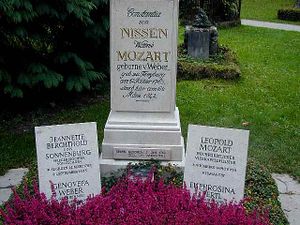
Little information is available on how Wolfgang took Leopolds' death, but a postscript he included in a letter to his friend Gottfried von Jacquin suggests that, despite the quarrels and partial estrangement, his father's death was a blow to him: "I inform you that on returning home today I received the sad news of my most beloved father's death. You can imagine the state I am in."
Assessment
The assessment of Leopold Mozart as a person and as a father brings forth serious disagreement among scholars. The Grove Dictionary article, by Cliff EisenCliff Eisen
Cliff Eisen is a Canadian musicologist and a Mozart expert. He has been based, since 1997, in the Department of Music at King's College London. As part of the Department's strong connections with the Royal Academy of Music, Eisen also leads courses there...
, denounces "his misrepresentation at the hands of later biographers":
- "A man of broad cultural achievement ... Leopold Mozart may have been haughty, difficult to please and at times intractable, ... but there is no compelling evidence that Mozart was excessively manipulative, intolerant, autocratic or jealous of his son’s talent. On the contrary, a careful reading in context of the family letters reveals a father who cared deeply for his son but who was frequently frustrated in his greatest ambition: to secure for Wolfgang a worldly position appropriate to his genius."
A harsher view is taken by Maynard Solomon, who portrays Leopold as a man who loved his children but was unwilling to give them their independence when they reached adulthood, resulting in considerable hardship for them.
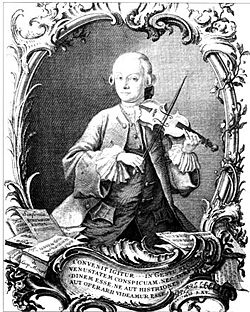
Musical works
- See :Category:Compositions by Leopold Mozart
Leopold Mozart's music is inevitably overshadowed by the work of his son Wolfgang, and in any case the father willingly sacrificed his own career to promote his son's. But Leopold's Cassation in G for Orchestra and Toys (Toy Symphony
Toy Symphony
The Toy Symphony is a musical work with parts for toy instruments and is popularly played at Christmas....
), once attributed to Joseph Haydn
Joseph Haydn
Franz Joseph Haydn , known as Joseph Haydn , was an Austrian composer, one of the most prolific and prominent composers of the Classical period. He is often called the "Father of the Symphony" and "Father of the String Quartet" because of his important contributions to these forms...
, remains popular, and a number of symphonies, a trumpet concerto
Trumpet Concerto (Leopold Mozart)
Leopold Mozart's Trumpet Concerto in D major was completed in 1762, and is now "popular with trumpeters." The work is in two movements:*I. Largo*II. Allegro moderatoBesides the solo trumpet in D, the concerto is scored for two horns in D and strings...
, and other works also survive.
A contemporary report described what Leopold had composed prior to 1757:
- "many contrapuntalCounterpointIn music, counterpoint is the relationship between two or more voices that are independent in contour and rhythm and are harmonically interdependent . It has been most commonly identified in classical music, developing strongly during the Renaissance and in much of the common practice period,...
and other church items; further a great number of symphonies, some only à 4 but others with all the customary instruments; likewise more than 30 large serenadeSerenadeIn music, a serenade is a musical composition, and/or performance, in someone's honor. Serenades are typically calm, light music.The word Serenade is derived from the Italian word sereno, which means calm....
s in which solos for various instruments appear. In addition he has brought forth many concertos, in particular for the transverse flute, oboe, bassoon, WaldhornHorn (instrument)The horn is a brass instrument consisting of about of tubing wrapped into a coil with a flared bell. A musician who plays the horn is called a horn player ....
, trumpet etc.: countless trios and divertimentoDivertimentoDivertimento is a musical genre, with most of its examples from the 18th century. The mood of the divertimento is most often lighthearted and it is generally composed for a small ensemble....
s for various instruments; 12 oratorioOratorioAn oratorio is a large musical composition including an orchestra, a choir, and soloists. Like an opera, an oratorio includes the use of a choir, soloists, an ensemble, various distinguishable characters, and arias...
s and a number of theatrical items, even pantomimes, and especially certain occasional pieces such as martial music … Turkish musicTurkish music (style)"Turkish music", in the sense described here, is not music of Turkey, but rather a musical style called Alla turca that was occasionally used by European composers of the 17th and 18th centuries...
, music with 'steel keyboard' and lastly a musical sleigh ride; not to speak of marches, so-called 'Nachtstücke' and many hundreds of minuetMinuetA minuet, also spelled menuet, is a social dance of French origin for two people, usually in 3/4 time. The word was adapted from Italian minuetto and French menuet, and may have been from French menu meaning slender, small, referring to the very small steps, or from the early 17th-century popular...
s, opera dances and similar items.
Leopold Mozart was much concerned with a naturalistic feel to his compositions, his Jagdsinfonie
Jagdsinfonie
The Jagdsinfonie or Sinfonia da Caccia for 4 horns and Strings is a work by Leopold Mozart in G major. It is scored for corni di caccia, or hunting horns, strings, gunshots, shouting and barking dogs, a naturalism not atypical of this composer.Movements:...
(or Sinfonia da Caccia for four horns and strings) calls for dogs and shotguns, and his Bauernhochzeit (Peasant Wedding) includes bagpipes
Bagpipes
Bagpipes are a class of musical instrument, aerophones, using enclosed reeds fed from a constant reservoir of air in the form of a bag. Though the Scottish Great Highland Bagpipe and Irish uilleann pipes have the greatest international visibility, bagpipes of many different types come from...
, hurdy-gurdy
Hurdy gurdy
The hurdy gurdy or hurdy-gurdy is a stringed musical instrument that produces sound by a crank-turned rosined wheel rubbing against the strings. The wheel functions much like a violin bow, and single notes played on the instrument sound similar to a violin...
, a dulcimer
Hammered dulcimer
The hammered dulcimer is a stringed musical instrument with the strings stretched over a trapezoidal sounding board. Typically, the hammered dulcimer is set on a stand, at an angle, before the musician, who holds small mallet hammers in each hand to strike the strings...
, whoops and whistles (ad. lib.), and pistol shots.
His oeuvre was extensive, but it has only been until recently that scholars have begun to assess the scope or the quality of it; much is lost and it is not known how representative the surviving works are of his overall output. Cliff Eisen, who wrote a doctoral dissertation on Leopold Mozart's symphonies, finds in a Symphony in G major examples of his "sensitivity to orchestral colour" and a work that "compares favourably with those of virtually any of Mozart’s immediate contemporaries."
Some of his work was erroneously attributed to Wolfgang and some pieces attributed to Leopold were subsequently shown to be the work of Wolfgang. Much of what survives is light music but some more significant work survives including his Sacrament Litany in D (1762) and three fortepiano
Fortepiano
Fortepiano designates the early version of the piano, from its invention by the Italian instrument maker Bartolomeo Cristofori around 1700 up to the early 19th century. It was the instrument for which Haydn, Mozart, and the early Beethoven wrote their piano music...
sonatas, all published in his lifetime.
External links
- Leopold Mozart, a biographical sketch at the site of the Mozart Project
- A French Edition of Leopold Mozart's Violinschule

